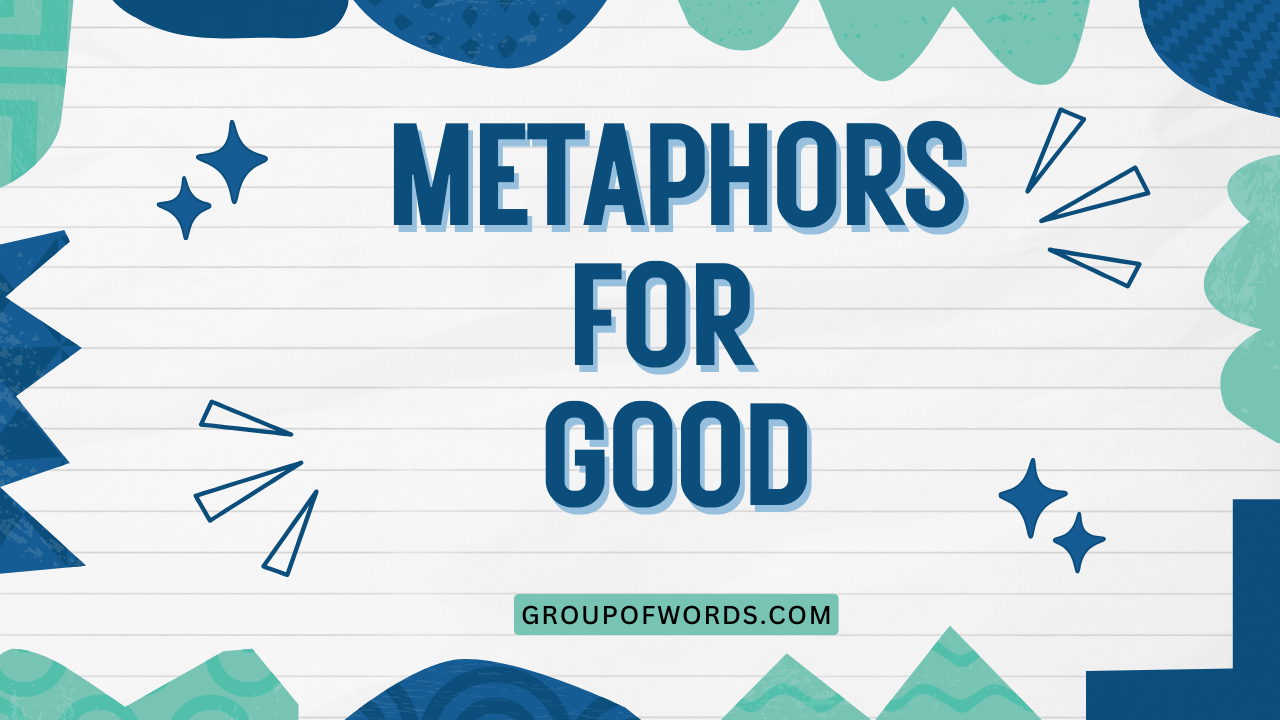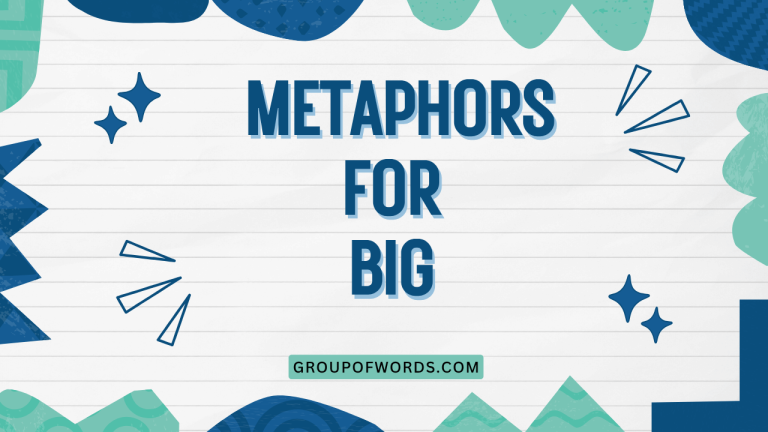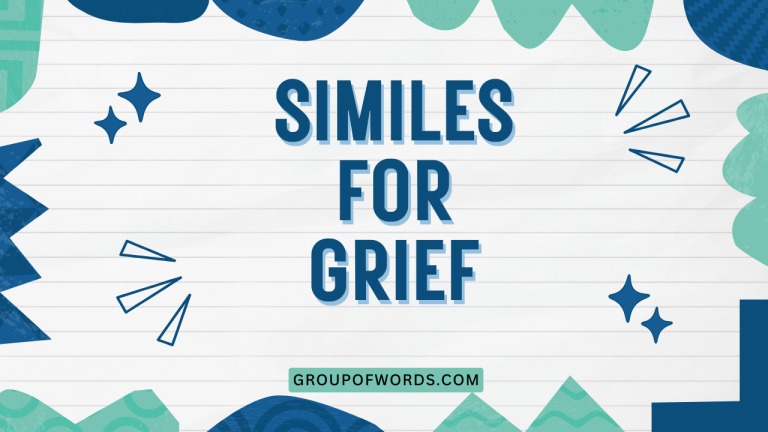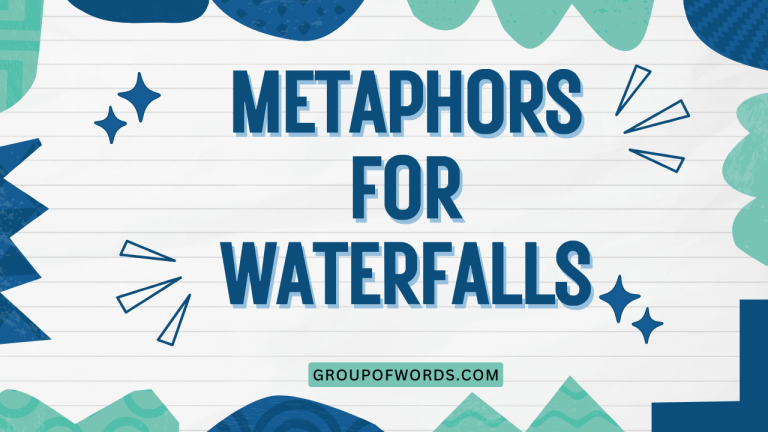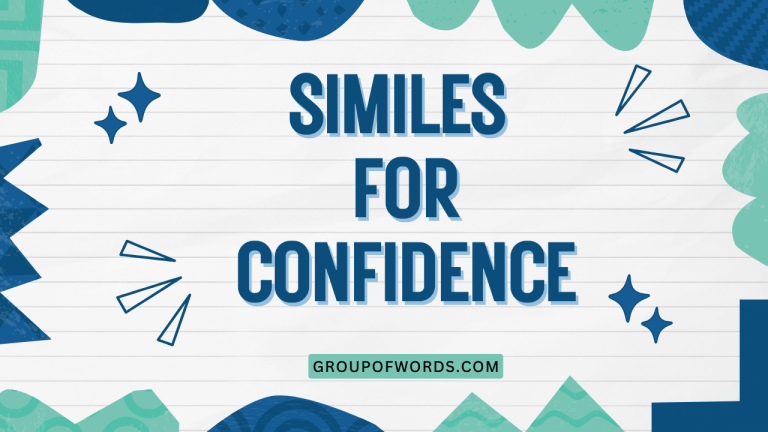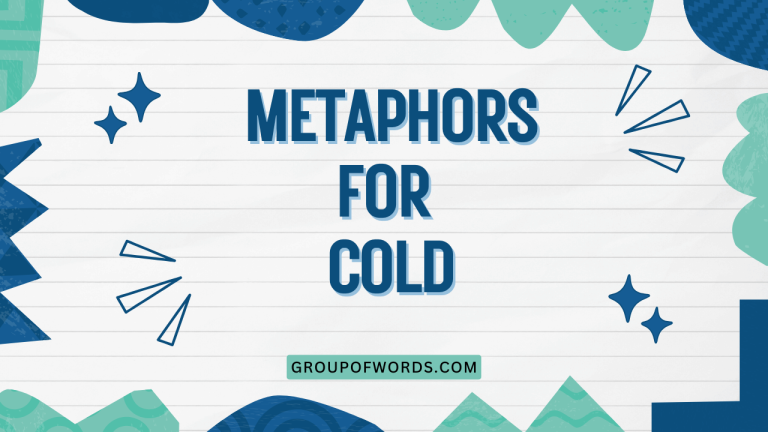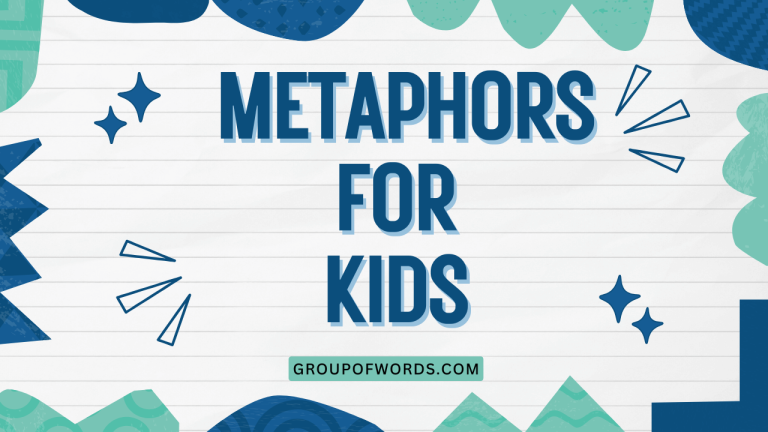Metaphors for Good: A Comprehensive Guide
Metaphors are powerful tools in the English language, allowing us to understand abstract concepts by relating them to more concrete ones. Understanding metaphors, especially those associated with positive concepts, enhances both your comprehension and expression.
This article explores various metaphors for “good,” examining their structure, usage, and impact. It is designed for English language learners of all levels, from beginners to advanced speakers, and offers practical exercises to solidify your understanding.
Table of Contents
- Introduction
- Definition of Metaphors for Good
- Structural Breakdown
- Types and Categories of Metaphors for Good
- Examples of Metaphors for Good
- Usage Rules for Metaphors for Good
- Common Mistakes
- Practice Exercises
- Advanced Topics
- FAQ
- Conclusion
Definition of Metaphors for Good
A metaphor is a figure of speech that directly compares two unlike things without using “like” or “as.” It asserts that one thing is another to highlight a shared quality or characteristic. Metaphors for “good” are used to describe positive qualities, experiences, or outcomes by associating them with something else that is inherently seen as beneficial or desirable. These metaphors help to convey the strength, depth, and impact of goodness in a creative and evocative way.
In essence, metaphors for good function by transferring the positive attributes of one concept (the source) to another (the target). For example, describing someone as “a beacon of hope” uses the source concept of a beacon (which guides and illuminates) to highlight the target concept of a person who provides hope and direction.
The effectiveness of a metaphor relies on the audience’s understanding of the source concept and its associated positive connotations. Without this shared understanding, the metaphor may fall flat or be misinterpreted.
Metaphors for good can be found in various contexts, including literature, everyday conversation, political speeches, and business communications. They are used to inspire, motivate, reassure, and create a sense of optimism.
Understanding these metaphors not only enhances comprehension but also enables more effective and persuasive communication.
Structural Breakdown
The basic structure of a metaphor involves two key elements: the tenor (or target) and the vehicle (or source). The tenor is the subject being described, and the vehicle is the concept used to describe it. The connection between the tenor and vehicle is the ground, which refers to the shared characteristics or qualities that make the metaphor meaningful.
Consider the metaphor “Honesty is a shining light.” Here:
- Tenor: Honesty
- Vehicle: Shining light
- Ground: Clarity, visibility, guidance, and positive association.
The structure can be further analyzed by examining the strength and complexity of the metaphor. A strong metaphor creates a vivid and memorable image, while a complex metaphor may involve multiple layers of meaning and interpretation. In addition, a metaphor may be explicit (directly stated) or implicit (implied or suggested). Explicit metaphors use a form of the verb “to be,” while implicit metaphors achieve comparison through suggestive language.
For example, “She nurtured the project like a garden” is explicit, while “Her dedication blossomed into success” is implicit, as it uses the verb “blossomed” to evoke the image of growth and flourishing without directly stating a comparison.
Understanding these structural elements allows for a deeper appreciation of how metaphors work and how they can be effectively used to convey meaning.
Types and Categories of Metaphors for Good
Metaphors for “good” can be categorized based on the specific domains or concepts they draw upon. Here are some common categories:
Light and Illumination
These metaphors associate goodness with light, clarity, and visibility. They often evoke feelings of hope, understanding, and guidance.
Examples include: a shining example, a beacon of hope, illuminating insights, shedding light on the truth, a bright future.
Growth and Nature
These metaphors link goodness with growth, flourishing, and the natural world. They convey ideas of development, potential, and abundance.
Examples include: a blossoming career, a fruitful partnership, planting seeds of kindness, a growing movement, the fruits of their labor.
Health and Wellness
These metaphors equate goodness with health, vitality, and well-being. They suggest strength, resilience, and positive condition.
Examples include: a healthy economy, a vibrant community, a sound mind, a robust system, a healing influence.
Nourishment and Sustenance
These metaphors connect goodness with nourishment, sustenance, and satisfaction. They imply support, fulfillment, and essential needs being met.
Examples include: food for thought, a nourishing experience, a wellspring of ideas, a source of comfort, feeding their ambition.
Upward Movement and Elevation
These metaphors associate goodness with upward movement, elevation, and progress. They suggest achievement, aspiration, and positive direction.
Examples include: rising to the occasion, reaching new heights, an upward trajectory, elevating the conversation, soaring to success.
Smoothness and Ease
These metaphors link goodness with smoothness, ease, and lack of obstacles. They convey ideas of harmony, efficiency, and pleasant experiences.
Examples include: a smooth transition, a seamless process, a clear path, a streamlined approach, flowing with ease.
Examples of Metaphors for Good
The following tables provide extensive examples of metaphors for good, categorized by type. Each example includes the metaphor, its literal meaning, and its intended metaphorical meaning.
Table 1: Light and Illumination Metaphors
This table illustrates how light-related terms are used to describe positive qualities and situations, focusing on clarity, guidance, and hope.
| Metaphor | Literal Meaning | Metaphorical Meaning |
|---|---|---|
| She is a shining star in the company. | A star emits bright light. | She is exceptionally talented and successful. |
| His honesty was a beacon of hope. | A beacon guides ships. | His honesty provided guidance and encouragement. |
| The new policy shed light on the issue. | Light makes things visible. | The policy clarified the issue. |
| Her ideas illuminated the discussion. | Light brightens a room. | Her ideas made the discussion clearer and more insightful. |
| They have a bright future ahead of them. | Brightness relates to light. | They have a promising future. |
| His wisdom is a guiding light for many. | A guiding light shows the way. | His wisdom provides direction and support. |
| The truth dawned on him. | Dawn is the beginning of daylight. | He suddenly understood the truth. |
| She is a ray of sunshine in his life. | Sunshine is warm and bright. | She brings joy and happiness. |
| The project was a spotlight on their talents. | A spotlight highlights something important. | The project showcased their talents. |
| His smile lit up the room. | Light makes a room brighter. | His smile made the room feel happier. |
| Her words were like a lamp in the darkness. | A lamp provides light in the dark. | Her words offered guidance and hope in a difficult situation. |
| He is a bright spark in the team. | A spark is a small flash of light. | He is intelligent and energetic. |
| The decision cast a shadow over their plans. | A shadow blocks light. | The decision negatively impacted their plans. |
| They are walking in the light of truth. | Light symbolizes truth. | They are acting honestly and ethically. |
| Her spirit is a bright flame. | A flame is a source of light and warmth. | Her spirit is vibrant and inspiring. |
| The discovery shone a light on new possibilities. | Light reveals what is hidden. | The discovery revealed new opportunities. |
| His optimism is a lighthouse in the storm. | A lighthouse guides ships safely. | His optimism provides guidance and reassurance during difficult times. |
| Her presence brightened the atmosphere. | Brightness enhances a space. | Her presence made the atmosphere more cheerful. |
| The agreement cleared up any misunderstandings. | Clearing something up makes it more visible. | The agreement resolved any confusion. |
| His insights sparkled with intelligence. | Sparkling suggests brilliance. | His insights were highly intelligent and perceptive. |
| The new evidence threw the case into a new light. | Light changes perception. | The new evidence changed the perspective on the case. |
| She approached the problem with a clear vision. | Clear vision means seeing things distinctly. | She had a precise and focused approach. |
| The solution was a flash of inspiration. | A flash is a sudden burst of light. | The solution was a sudden and brilliant idea. |
| His leadership illuminated the path forward. | Illumination provides direction. | His leadership guided the way forward. |
Table 2: Growth and Nature Metaphors
This table focuses on how terms related to growth, plants, and nature are used to describe positive developments, potential, and outcomes.
| Metaphor | Literal Meaning | Metaphorical Meaning |
|---|---|---|
| Their relationship blossomed into a deep connection. | Flowers bloom and grow. | Their relationship developed into a strong bond. |
| The project bore fruit after years of hard work. | Trees produce fruit. | The project yielded positive results. |
| She planted the seeds of kindness wherever she went. | Seeds grow into plants. | She spread kindness through her actions. |
| The company is experiencing a period of rapid growth. | Plants grow in size. | The company is expanding quickly. |
| His ideas are a fertile ground for innovation. | Fertile ground supports plant growth. | His ideas encourage innovation. |
| The team nurtured the project with care. | Nurturing helps plants grow. | The team carefully developed the project. |
| Their efforts yielded a rich harvest of success. | Harvest is the gathering of crops. | Their efforts produced significant success. |
| The new initiative is a budding opportunity. | A bud is the early stage of a flower. | The new initiative is a promising opportunity. |
| He is a towering figure in the industry. | Tall trees are impressive. | He is a highly influential and respected person. |
| The agreement provided fertile soil for collaboration. | Fertile soil promotes growth. | The agreement created favorable conditions for collaboration. |
| Her creativity is a wellspring of ideas. | A wellspring is a source of water. | Her creativity is a constant source of new ideas. |
| The company has deep roots in the community. | Roots anchor a plant. | The company is firmly established in the community. |
| His advice was like a lifeline in the storm. | A lifeline provides safety. | His advice was crucial and helpful in a difficult situation. |
| The project grew organically over time. | Organic growth is natural. | The project developed naturally and progressively. |
| Her influence spread like wildfire. | Wildfire spreads rapidly. | Her influence expanded quickly and widely. |
| The partnership is a fruitful collaboration. | Fruitful means productive. | The partnership is producing positive results. |
| They cultivated a strong team spirit. | Cultivating promotes growth. | They developed a positive and supportive team environment. |
| His legacy will continue to flourish. | Flourishing means thriving. | His legacy will continue to be successful and influential. |
| The new policy is a seed of change. | A seed initiates growth. | The new policy is the beginning of significant change. |
| His potential is just beginning to sprout. | Sprouting is the initial stage of growth. | His potential is starting to become evident. |
| The company weathered the storm of the recession. | Weathering a storm means enduring it. | The company successfully survived the economic downturn. |
| Her wisdom is a deep-rooted strength. | Deep roots provide stability. | Her wisdom is a fundamental and unwavering strength. |
| The project is a green shoot of recovery. | Green shoots indicate new growth. | The project is a sign of positive progress. |
| Their relationship is a strong and sturdy tree. | A sturdy tree is resilient. | Their relationship is strong and enduring. |
| He has a natural talent for leadership. | Natural talent is innate. | He is inherently skilled at leading. |
Table 3: Health and Wellness Metaphors
This table demonstrates how terms related to health, vitality, and well-being are used to characterize positive conditions, systems, and influences.
| Metaphor | Literal Meaning | Metaphorical Meaning |
|---|---|---|
| The economy is in good health. | Good health means physical well-being. | The economy is performing well. |
| The community is vibrant and thriving. | Vibrancy suggests energy and life. | The community is active and prosperous. |
| He has a sound mind in a sound body. | Sound means healthy. | He is mentally and physically healthy. |
| The system is robust and resilient. | Robust means strong. | The system is strong and can withstand challenges. |
| Her influence was a healing presence. | Healing restores health. | Her influence was beneficial and restorative. |
| The company is in a state of recovery. | Recovery means regaining health. | The company is improving after a period of difficulty. |
| His leadership brought vitality to the team. | Vitality means energy and strength. | His leadership energized and strengthened the team. |
| The new policy is a healthy dose of reform. | A healthy dose is beneficial. | The new policy is a beneficial reform. |
| His advice was a tonic for her spirits. | A tonic is a restorative medicine. | His advice cheered her up. |
| The project breathed new life into the organization. | Breathing life means giving energy. | The project revitalized the organization. |
| Her optimism is infectious. | Infectious diseases spread quickly. | Her optimism inspires others. |
| The team is operating at full strength. | Full strength means maximum power. | The team is performing at its best. |
| His resilience is his greatest asset. | Resilience means ability to recover. | His ability to bounce back is his most valuable quality. |
| The initiative is a shot in the arm for the economy. | A shot in the arm is a boost. | The initiative is stimulating the economy. |
| Her determination is a powerful medicine. | Medicine heals and strengthens. | Her determination is a strong and effective force. |
| The company is fighting fit and ready for challenges. | Fighting fit means in excellent condition. | The company is well-prepared for any difficulties. |
| His ideas are a breath of fresh air. | Fresh air is revitalizing. | His ideas are new and refreshing. |
| The project is a sign of renewed health for the industry. | Renewed health means restored vitality. | The project indicates that the industry is recovering. |
| Her positive attitude is a shield against negativity. | A shield provides protection. | Her positive attitude protects her from negative influences. |
| The team’s synergy is a life force for the project. | A life force provides energy. | The team’s collaboration is essential for the project’s success. |
| The company is in a healthy financial position. | Healthy financial position means stable finances. | The company’s finances are stable and secure. |
| His encouragement was like a soothing balm to her hurt feelings. | A balm heals and comforts. | His encouragement eased her emotional pain. |
| The new policy aims to cure the problems in the system. | Curing eliminates ailments. | The new policy seeks to resolve the systemic issues. |
| She is a pillar of strength for her family. | A pillar provides support. | She is a strong and reliable source of support for her family. |
| The community is building a strong immune system against crime. | An immune system fights off disease. | The community is developing defenses against crime. |
Table 4: Nourishment and Sustenance Metaphors
This table shows how food and sustenance-related terms describe positive experiences, ideas, and support.
| Metaphor | Literal Meaning | Metaphorical Meaning |
|---|---|---|
| His lecture was food for thought. | Food nourishes the body. | His lecture provided intellectual stimulation. |
| The experience was a nourishing opportunity. | Nourishment sustains life. | The experience was enriching and fulfilling. |
| She is a wellspring of ideas. | A wellspring provides water. | She is a constant source of new ideas. |
| His words were a source of comfort. | A source provides essential resources. | His words provided emotional support. |
| They are feeding their ambition. | Feeding sustains growth. | They are nurturing their ambition. |
| The book is a feast for the mind. | A feast is a large meal. | The book is intellectually stimulating. |
| Her support was a lifeline during the crisis. | A lifeline provides essential support. | Her support was crucial during the crisis. |
| His encouragement was the fuel she needed to succeed. | Fuel powers machines. | His encouragement motivated her to succeed. |
| The project is a breadwinner for the company. | A breadwinner provides income. | The project is a major source of revenue for the company. |
| Her wisdom is a treasure trove of knowledge. | A treasure trove is a store of valuable items. | Her wisdom is a vast source of knowledge. |
| His words were like honey to her ears. | Honey is sweet and pleasing. | His words were very pleasing to her. |
| The conference was a buffet of information. | A buffet offers a variety of foods. | The conference provided a wide range of information. |
| She is a fountain of inspiration. | A fountain provides a continuous flow of water. | She is a constant source of inspiration. |
| His ideas are the salt of the earth. | Salt enhances flavor. | His ideas are valuable and essential. |
| The program is a lifeline for struggling families. | A lifeline provides essential support. | The program provides crucial assistance to struggling families. |
| Her kindness is a sweet treat. | Treats are enjoyable. | Her kindness is delightful. |
| The new policy is designed to nourish innovation. | Nourishing promotes growth. | The new policy aims to foster innovation. |
| His insights are the spice of the conversation. | Spice adds flavor. | His insights make the conversation more interesting. |
| The project is a cash cow for the company. | A cash cow generates significant revenue. | The project provides substantial profits for the company. |
| Her support was like water in the desert. | Water is essential in the desert. | Her support was crucial and revitalizing in a difficult situation. |
| His speech was full of meaty arguments. | Meat is substantial and nutritious. | His speech contained strong and significant arguments. |
| The workshop was a smorgasbord of new techniques. | A smorgasbord offers a variety of dishes. | The workshop provided a wide range of new techniques. |
| She is a gold mine of information. | A gold mine is a source of valuable resources. | She is a rich source of information. |
| His advice was pure gold. | Gold is valuable and precious. | His advice was extremely valuable and helpful. |
Usage Rules for Metaphors for Good
Using metaphors effectively requires understanding several key rules:
- Relevance: The connection between the tenor and vehicle must be clear and relevant. The shared characteristics should be easily understood by the audience.
- Originality: While some metaphors are common, using original and creative metaphors can make your writing more engaging and memorable. However, avoid being too obscure or confusing.
- Consistency: Avoid mixing metaphors within the same context. Maintain a consistent image or theme to prevent confusion. For example, don’t mix a light metaphor with a growth metaphor in the same sentence.
- Appropriateness: Consider the context and audience when choosing a metaphor. A metaphor that works well in a literary context may not be appropriate for a formal business presentation.
- Clarity: Ensure that the metaphor enhances understanding rather than obscuring it. If the metaphor is too complex or unfamiliar, it may confuse the audience.
It’s also important to avoid clichés, which are overused metaphors that have lost their impact. Examples of cliché metaphors include “as strong as an ox” or “as wise as an owl.” While clichés can be easily understood, they lack originality and can make your writing sound uninspired. Instead, strive to create fresh and imaginative metaphors that capture the reader’s attention.
Furthermore, pay attention to the emotional tone of the metaphor. Metaphors can evoke strong emotions, so choose metaphors that align with the intended message and desired emotional response. For example, a light metaphor may evoke feelings of hope and optimism, while a growth metaphor may convey a sense of potential and progress.
Finally, remember that metaphors are not meant to be taken literally. They are figures of speech that use comparison to convey meaning, so avoid interpreting them in a literal sense.
Instead, focus on the underlying message and the shared characteristics between the tenor and vehicle.
Common Mistakes
Several common mistakes can hinder the effective use of metaphors:
- Mixed Metaphors: Combining unrelated images, creating confusion.
- Clichés: Using overused, unoriginal metaphors that lack impact.
- Obscurity: Employing metaphors that are too complex or unfamiliar, leading to misunderstanding.
- Inappropriateness: Selecting metaphors that are unsuitable for the context or audience.
- Literal Interpretation: Misunderstanding the figurative nature of metaphors and taking them too literally.
Table 5: Correct vs. Incorrect Metaphor Usage
This table highlights common errors in metaphor usage and provides corrected versions to illustrate best practices.
| Incorrect | Correct | Explanation |
|---|---|---|
| The project is a shining star and a fruitful endeavor. | The project is a shining star. / The project is a fruitful endeavor. | Avoid mixing light and growth metaphors in the same sentence. Use separate metaphors for clarity. |
| He is as strong as an ox and sharp as a tack. | He is incredibly strong. / He is exceptionally sharp. | Avoid clichés. Use more original and descriptive language. |
| Her ideas were a labyrinth of quantum entanglement. | Her ideas were complex and intricate. | Avoid obscure metaphors. Use simpler language for broader understanding. |
| The company is a garden of innovation in a desert of bureaucracy. | The company is a garden of innovation. / The bureaucracy is a desert. | Avoid mixing two metaphors in a way that creates a confusing image. Separate the ideas. |
| The agreement is a concrete jungle. | The agreement is a complex and challenging situation. | Ensure the metaphor is relevant and easily understood by the audience. |
| The plan is a bridge over troubled water and a beacon of hope. | The plan is a bridge over troubled water. / The plan is a beacon of hope. | Avoid mixing metaphors. Choose one that best represents the intended meaning. |
| His leadership is a roaring fire and a guiding light. | His leadership is a guiding light. | Maintain consistency. Choose a single, impactful metaphor. |
| The new strategy is a shot in the dark and a breath of fresh air. | The new strategy is a breath of fresh air. | Select a metaphor that accurately reflects the intended message. |
| Her kindness is a warm blanket and a green light. | Her kindness is a warm blanket. | Avoid contradictory images. Choose a metaphor that aligns with the context. |
| The project is a rollercoaster and a smooth sailing ship. | The project is a smooth sailing ship. | Ensure the metaphor enhances understanding rather than obscuring it. |
Practice Exercises
Test your understanding with these practice exercises:
Exercise 1: Identifying Metaphors
Identify the metaphor in each sentence and explain its meaning.
| Question | Answer |
|---|---|
| 1. His words were a soothing balm to her wounded spirit. | Metaphor: Soothing balm. Meaning: His words provided comfort and healing. |
| 2. The new policy is a breath of fresh air for the company. | Metaphor: Breath of fresh air. Meaning: The policy is revitalizing and positive. |
| 3. She is a fountain of inspiration for her students. | Metaphor: Fountain of inspiration. Meaning: She is a constant source of new ideas and motivation. |
| 4. The project bore fruit after years of dedication. | Metaphor: Bore fruit. Meaning: The project yielded positive results. |
| 5. His advice was pure gold. | Metaphor: Pure gold. Meaning: His advice was extremely valuable and helpful. |
| 6. The agreement is a bridge between the two companies. | Metaphor: Bridge. Meaning: The agreement connects and facilitates communication. |
| 7. The team’s synergy is a life force for the project. | Metaphor: Life force. Meaning: The team’s collaboration is essential for the project’s success. |
| 8. The company is a cash cow for its investors. | Metaphor: Cash cow. Meaning: The company generates significant profits. |
| 9. His optimism is a lighthouse in the storm. | Metaphor: Lighthouse. Meaning: His optimism provides guidance and reassurance during difficult times. |
| 10. She is a pillar of strength for her family. | Metaphor: Pillar of strength. Meaning: She is a strong and reliable source of support. |
Exercise 2: Completing Metaphors
Complete the following sentences by adding a suitable metaphor for “good.”
| Question | Answer |
|---|---|
| 1. His leadership was a ________ for the struggling team. | Answer: Guiding light |
| 2. The new program is a ________ for underprivileged children. | Answer: Lifeline |
| 3. Her kindness is a ________ to everyone she meets. | Answer: Ray of sunshine |
| 4. The discovery was a ________ of new possibilities. | Answer: Seed |
| 5. The community is a ________ of support for its members. | Answer: Wellspring |
| 6. His insights are the ________ of the conversation. | Answer: Spice |
| 7. Her determination is a ________ for overcoming challenges. | Answer: Powerful medicine |
| 8. The company’s success is a ________ of its hard work. | Answer: Fruit |
| 9. The agreement is a ________ towards a better future. | Answer: Bridge |
| 10. Her wisdom is a ________ for those seeking guidance. | Answer: Guiding light |
Exercise 3: Correcting Mixed Metaphors
Identify and correct the mixed metaphors in the following sentences.
| Question | Answer |
|---|---|
| 1. The project is a shining star and a smooth sailing ship. | Answer: The project is a shining star. / The project is a smooth sailing ship. |
| 2. His ideas are a wellspring of inspiration and a shot in the dark. | Answer: His ideas are a wellspring of inspiration. |
| 3. The new policy is a breath of fresh air and a concrete jungle. | Answer: The new policy is a breath of fresh air. |
Advanced Topics
For advanced learners, consider these more complex aspects of metaphors:
- Extended Metaphors: These are metaphors that are sustained over several lines or paragraphs, creating a more complex and nuanced comparison.
- Dead Metaphors: These are metaphors that have become so common that they are no longer recognized as metaphors (e.g., “the heart of the matter”).
- Conceptual Metaphors: These are underlying conceptual systems that shape our understanding of abstract concepts (e.g., “argument is war”).
- Metaphorical Reasoning: This involves using metaphors to draw inferences and make predictions about the target domain based on the source domain.
Exploring these advanced topics can deepen your understanding of how metaphors function and how they can be used to create powerful and persuasive communication.
FAQ
1. What is the difference between a metaphor and a simile?
A metaphor directly compares two unlike things by stating that one thing is another, while a simile uses “like” or “as” to make a comparison. For example, “He is a lion” (metaphor) vs. “He is as brave as a lion” (simile).
2. How can I create original metaphors?
To create original metaphors, try to think outside the box and look for unexpected connections between seemingly unrelated things. Consider the qualities or characteristics that you want to emphasize and then brainstorm different images or concepts that share those qualities.
3. Are metaphors universal?
While some metaphors are based on universal human experiences, many metaphors are culturally specific and may not be easily understood by people from different backgrounds. It’s important to be aware of cultural differences when using metaphors.
4. Can metaphors be used in formal writing?
Yes, metaphors can be used in formal writing, but it’s important to use them judiciously and ensure that they are appropriate for the context and audience. Avoid using overly informal or colloquial metaphors in formal settings.
5. How do I avoid mixing metaphors?
To avoid mixing metaphors, maintain a consistent image or theme throughout your writing. Avoid combining unrelated images or concepts that create confusion.
If you want to use multiple metaphors, use them in separate sentences or paragraphs.
Conclusion
Metaphors for “good” are powerful tools for enhancing communication and understanding. By grasping their structure, types, and usage rules, English language learners can improve their ability to express positive concepts in a vivid and memorable way.
Through practice and attention to detail, you can master the art of using metaphors effectively to inspire, motivate, and create a sense of optimism in your writing and speaking. Keep exploring, experimenting, and refining your skills to unlock the full potential of metaphors in your language repertoire.
